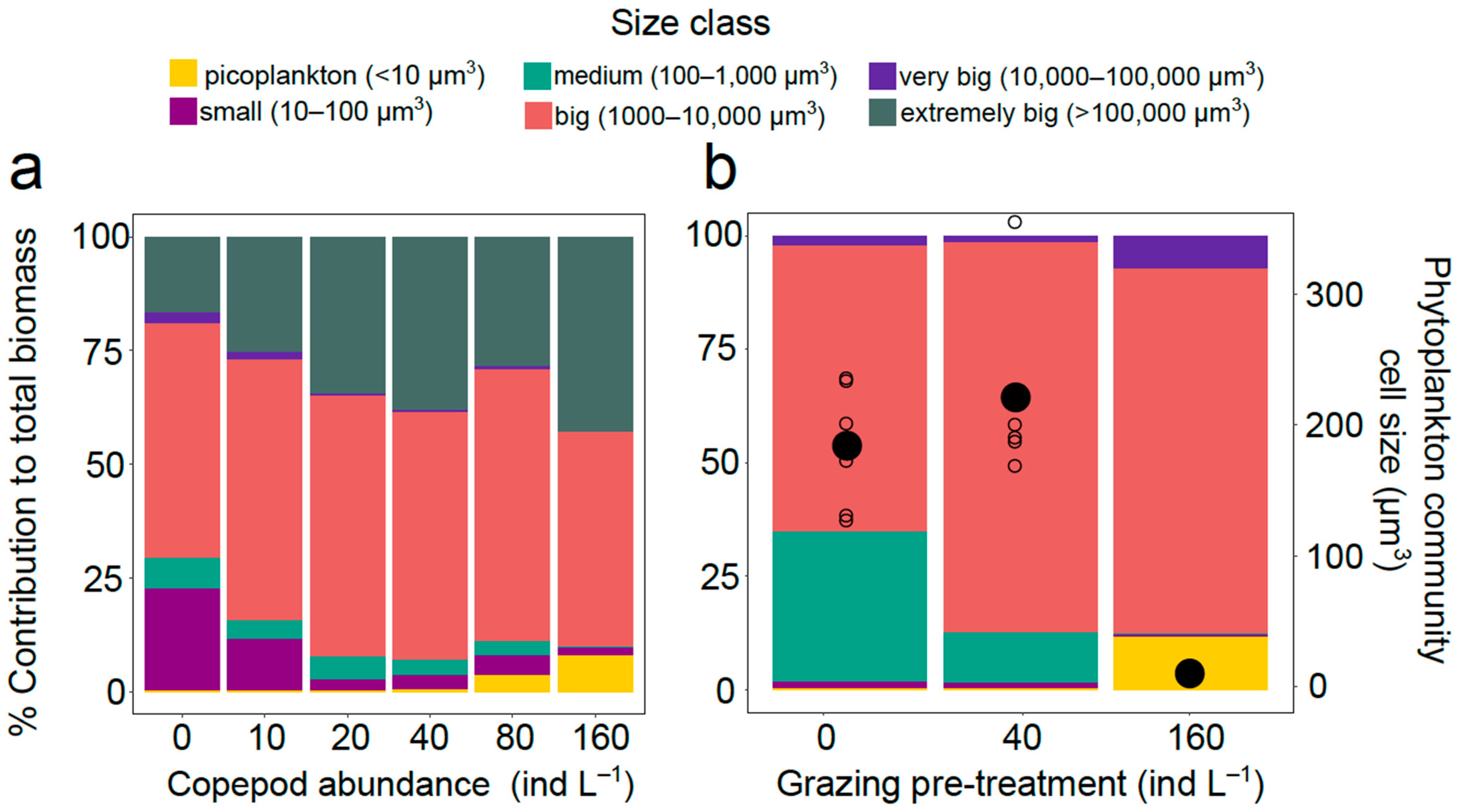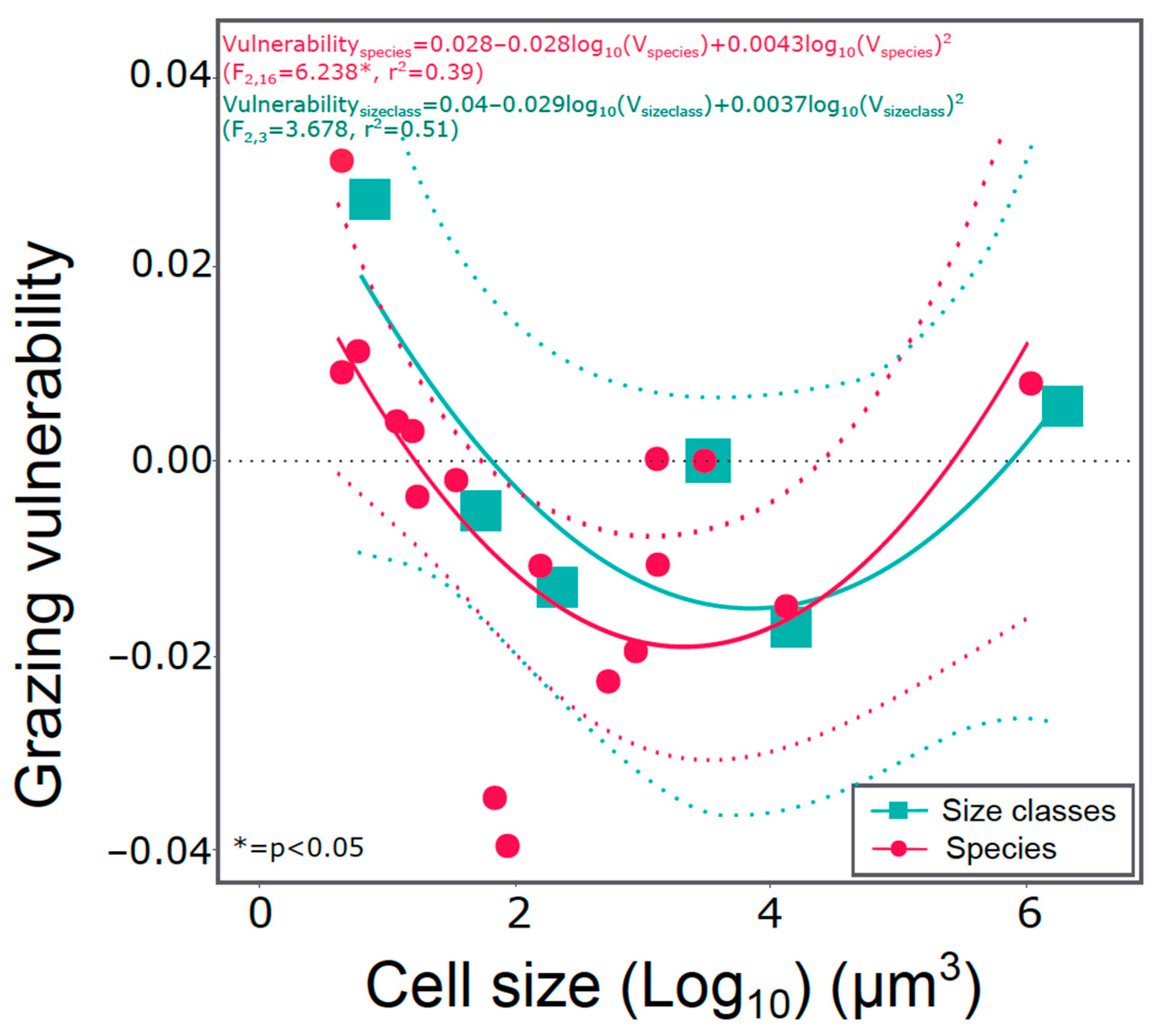Grazing Induced Shifts in Phytoplankton Cell Size Explain the Community Response to Nutrient Supply
Abstract
:1. Introduction
2. Materials and Methods
2.1. Experimental Design
2.2. Sampling and Measurements
2.3. Statistical Analysis
3. Results
3.1. Grazing Phase
3.2. Response to Nutrients
3.3. Cell Size Effect on Phytoplankton Traits
4. Discussion
5. Conclusions
Supplementary Materials
Author Contributions
Funding
Institutional Review Board Statement
Informed Consent Statement
Data Availability Statement
Aknowledgements
Conflicts of Interest
References
- Peter, K.H.; Sommer, U. Phytoplankton cell size, inter- and intraspecific effects of warming and grazing. PLoS ONE 2012, 7, e49632. [Google Scholar] [CrossRef] [PubMed] [Green Version]
- Peter, K.H.; Sommer, U. Phytoplankton Cell Size Reduction in Response to Warming Mediated by Nutrient Limitation. PLoS ONE 2013, 8, e71528. [Google Scholar] [CrossRef] [Green Version]
- Winder, M.; Sommer, U. Phytoplankton response to a changing climate. Hydrobiologia 2012, 698, 5–16. [Google Scholar] [CrossRef]
- Litchman, E.; Pinto, P.T.; Edwards, K.F.; Klausmeier, C.A.; Kremer, C.T.; Thomas, M.K. Global biogeochemical impacts of phytoplankton: A trait-based perspective. J. Ecol. 2015, 103, 1384–1396. [Google Scholar] [CrossRef] [Green Version]
- Litchman, E.; Klausmeier, C.A. Trait-Based Community Ecology of Phytoplankton. Annu. Rev. Ecol. Evol. Syst. 2008, 39, 615–639. [Google Scholar] [CrossRef] [Green Version]
- Finkel, Z.V.; Beardall, J.; Flynn, K.J.; Quigg, A.; Rees, T.A.V.; Raven, J.A. Phytoplankton in a changing world: Cell size and elemental stoichiometry. J. Plankton Res. 2010, 32, 119–137. [Google Scholar] [CrossRef] [Green Version]
- Irwin, A.J.; Finkel, Z.V. Phytoplankton functional types: A trait perspective. bioRxiv 2017, 148312. [Google Scholar] [CrossRef] [Green Version]
- Banse, K. Cell volumes, maximal growth rates of unicellular algae and ciliates, and the role of ciliates in the marine pelagial. Limnol. Oceanogr. 1982, 27, 1059–1071. [Google Scholar] [CrossRef]
- Sommer, U. Maximal growth rates of Antarctic phytoplankton: Only weak dependence on cell size. Limnol. Oceanogr. 1989, 34, 1109–1112. [Google Scholar] [CrossRef] [Green Version]
- Tang, E.P.; Sanders, J.G.; Vermersch, P.S. The allometry of algal growth rates. J. Plankton Res. 1995, 17, 1325–1335. [Google Scholar] [CrossRef]
- Edwards, K.F.; Thomas, M.K.; Klausmeier, C.A.; Litchman, E. Allometric scaling and taxonomic variation in nutrient utilization traits and maximum growth rate of phytoplankton. Limnol. Oceanogr. 2012, 57, 554–566. [Google Scholar] [CrossRef] [Green Version]
- Marañón, E.; Cermeno, P.; Sandoval, D.C.L.; Rodríguez-Ramos, T.; Sobrino, C.; Huete-Ortega, M.; Blanco, J.M.; Rodríguez, J. Unimodal size scaling of phytoplankton growth and the size dependence of nutrient uptake and use. Ecol. Lett. 2013, 16, 371–379. [Google Scholar] [CrossRef]
- Edwards, K.F.; Klausmeier, C.A.; Litchman, E. Evidence for a three-way trade-off between nitrogen and phosphorus competitive abilities and cell size in phytoplankton. Ecology 2011, 92, 2085–2095. [Google Scholar] [CrossRef] [PubMed] [Green Version]
- Elitchman, E.; Edwards, K.F.; Klausmeier, C.A. Microbial resource utilization traits and trade-offs: Implications for community structure, functioning, and biogeochemical impacts at present and in the future. Front. Microbiol. 2015, 6, 254. [Google Scholar] [CrossRef] [Green Version]
- Sommer, U. Comparison between steady state and non-steady state competition: Experiments with natural phytoplankton. Limnol. Oceanogr. 1985, 30, 335–346. [Google Scholar] [CrossRef]
- Sommer, U.; Charalampous, E.; Genitsaris, S.; Moustaka-Gouni, M. Costs, benefits and taxonomic distribution of phytoplankton body size. J. Plankton Res. 2016, 39, 494–508. [Google Scholar] [CrossRef]
- Wirtz, K.W. Who is eating whom? Morphology and feeding type determine the size relation between planktonic predators and their ideal prey. Mar. Ecol. Prog. Ser. 2012, 445, 1–12. [Google Scholar] [CrossRef] [Green Version]
- Sommer, U.; Sommer, F.; Santer, B.; Jamieson, C.; Boersma, M.; Becker, C.; Hansen, T. Complementary impact of copepods and cladocerans on phytoplankton. Ecol. Lett. 2001, 4, 545–550. [Google Scholar] [CrossRef] [Green Version]
- Calbet, A.; Saiz, E. The ciliate-copepod link in marine ecosystems. Aquat. Microb. Ecol. 2005, 38, 157–167. [Google Scholar] [CrossRef]
- Sommer, U.; Sommer, F. Cladocerans versus copepods: The cause of contrasting top–down controls on freshwater and marine phytoplankton. Oecologia 2005, 147, 183–194. [Google Scholar] [CrossRef]
- Vinebrooke, R.D.; Cottingham, K.L.; Norberg, M.S.J.; Dodson, S.I.; Maberly, S.C.; Sommer, U. Impacts of multiple stressors on biodiversity and ecosystem functioning: The role of species co-tolerance. Oikos 2004, 104, 451–457. [Google Scholar] [CrossRef]
- Lavorel, S.; Garnier, E. Aardvarck to Zyzyxia—functional groups across kingdoms. New Phytol. 2001, 149, 360–363. [Google Scholar] [CrossRef]
- Hooper, D.U.; Solan, M.; Symstad, A.; Diaz, S.; Gessner, M.O.; Buchmann, N.; Degrange, V.; Grime, P.; Hulot, F.; Mermillod-Blondin, F.; et al. Species diversity, functional diversity, and ecosystem functioning. In Biodiversity and Ecosystem Functioning—Synthesis and Perspectives; al Loreau, M., Ed.; Oxford University Press: Oxford, UK, 2002; pp. 195–208. [Google Scholar]
- Hillebrand, H.; Matthiessen, B. Biodiversity in a complex world: Consolidation and progress in functional biodiversity research. Ecol. Lett. 2009, 12, 1405–1419. [Google Scholar] [CrossRef]
- Paul, C.; Matthiessen, B.; Sommer, U. Warming, but not enhanced CO2 concentration, quantitatively and qualitatively affects phytoplankton biomass. Mar. Ecol. Prog. Ser. 2015, 528, 39–51. [Google Scholar] [CrossRef] [Green Version]
- Sommer, U.; Paul, C.; Moustaka-Gouni, M. Warming and Ocean Acidification Effects on Phytoplankton—From Species Shifts to Size Shifts within Species in a Mesocosm Experiment. PLoS ONE 2015, 10, e0125239. [Google Scholar] [CrossRef] [PubMed] [Green Version]
- Brock, T.D. Calculating solar radiation for ecological studies. Ecol. Model. 1981, 14, 1–19. [Google Scholar] [CrossRef]
- Lewandowska, A.; Sommer, U. Climate change and the spring bloom: A mesocosm study on the influence of light and temperature on phytoplankton and mesozooplankton. Mar. Ecol. Prog. Ser. 2010, 405, 101–111. [Google Scholar] [CrossRef] [Green Version]
- Paul, C.; Sommer, U.; Garzke, J.; Moustaka-Gouni, M.; Paul, A.; Matthiessen, B. Effects of increased CO2 concentration on nutrient limited coastal summer plankton depend on temperature. Limnol. Oceanogr. 2016, 61, 853–868. [Google Scholar] [CrossRef] [Green Version]
- Hansen, H.P.; Koroleff, F. Determination of nutrients. In Methods of Seawater Analysis, 3rd ed.; Grasshoff, K., Kremling, K., Ehrhardt, M., Eds.; Wiley VCH: Weinheim, Germany, 1999; pp. 159–228. [Google Scholar]
- Rott, E. Some results from phytoplankton counting intercalibrations. Aquat. Sci. 1981, 43, 34–62. [Google Scholar] [CrossRef]
- Utermöhl, H. Zur Vervollkommnung der quantitativen Phytoplankton-Methodik. Int. Ver. Theor. Angew. Limnol. Mitt. 1958, 9, 1–38. [Google Scholar] [CrossRef]
- Hillebrand, H.; Dürselen, C.-D.; Kirschtel, D.; Pollingher, U.; Zohary, T. Biovolume calculation for pelagic and benthic microalgae. J. Phycol. 1999, 35, 403–424. [Google Scholar] [CrossRef]
- Eppley, R.W. Temperature and phytoplankton growth in the sea. Fish. Bull. 1972, 70, 1063–1085. [Google Scholar]
- Sommer, U.; Hansen, T.; Blum, O.; Holzner, N.; Vadstein, O.; Stibor, H. Copepod and microzooplankton grazing in mesocosms fertilised with different Si:N ratios: No overlap between food spectra and Si:N influence on zooplankton trophic level. Oecologia 2004, 142, 274–283. [Google Scholar] [CrossRef] [PubMed]
- Sommer, U.; Lewandowska, A. Climate change and the phytoplankton spring bloom: Warming and overwintering zooplankton have similar effects on phytoplankton. Glob. Chang. Biol. 2010, 17, 154–162. [Google Scholar] [CrossRef]
- Blasco, D.; Packard, T.T.; Garfield, P.C. Size dependence of growth rate, respiratory electron transport system activity and chemical composition of marine diatoms in the laboratory. J. Phycol. 1982, 18, 58–63. [Google Scholar] [CrossRef]
- Charalampous, E.; Matthiessen, B.; Sommer, U. Light effects on phytoplankton morphometric traits influence nutrient utilization ability. J. Plankton Res. 2018, 40, 568–579. [Google Scholar] [CrossRef]
- Tang, E.P.Y. Why do dinoflagellates have lower growth rates? J. Phycol. 1996, 32, 80–84. [Google Scholar] [CrossRef]




| Growth Rate | Factor | Df | Sum Sq | Mean Sq | F |
|---|---|---|---|---|---|
| Total Community | Pregrazing | 2 | 0.06 | 0.03 | 2.8 |
| Nutrients | 1 | 0.49 | 0.49 | 43.3 * | |
| Pregrazing × Nutrients | 2 | 0.04 | 0.02 | 1.6 | |
| Size classes(μm3) | |||||
| Picoplankton (<10) | Pregrazing | 2 | 1.31 | 0.65 | 66.4 * |
| Nutrients | 1 | 0.18 | 0.18 | 18.5 * | |
| Pregrazing × Nutrients | 2 | 0.01 | 0.01 | 0.6 | |
| Small (10–100) | Pregrazing | 2 | 1.52 | 0.76 | 20.5 * |
| Nutrients | 1 | 0.78 | 0.78 | 21.1 * | |
| Pregrazing × Nutrients | 2 | 0.13 | 0.07 | 1.8 | |
| Medium (100–1000) | Pregrazing | 2 | 0.32 | 0.16 | 1.4 |
| Nutrients | 1 | 0.72 | 0.72 | 6.6 * | |
| Pregrazing × Nutrients | 2 | 0.30 | 0.15 | 1.4 | |
| Big (1000–10,000) | Pregrazing | 2 | 0.09 | 0.05 | 1.8 |
| Nutrients | 1 | 0.68 | 0.68 | 27.5 * | |
| Pregrazing × Nutrients | 2 | 0.06 | 0.03 | 1.2 | |
| Very big (>10,000) | Pregrazing | 2 | 3.25 | 1.63 | 19.8 * |
| Nutrients | 1 | 0.66 | 0.66 | 8 * | |
| Pregrazing × Nutrients | 2 | 0.12 | 0.06 | 0.7 |
Publisher’s Note: MDPI stays neutral with regard to jurisdictional claims in published maps and institutional affiliations. |
© 2021 by the authors. Licensee MDPI, Basel, Switzerland. This article is an open access article distributed under the terms and conditions of the Creative Commons Attribution (CC BY) license (https://creativecommons.org/licenses/by/4.0/).
Share and Cite
Charalampous, E.; Matthiessen, B.; Sommer, U. Grazing Induced Shifts in Phytoplankton Cell Size Explain the Community Response to Nutrient Supply. Microorganisms 2021, 9, 2440. https://doi.org/10.3390/microorganisms9122440
Charalampous E, Matthiessen B, Sommer U. Grazing Induced Shifts in Phytoplankton Cell Size Explain the Community Response to Nutrient Supply. Microorganisms. 2021; 9(12):2440. https://doi.org/10.3390/microorganisms9122440
Chicago/Turabian StyleCharalampous, Evangelia, Birte Matthiessen, and Ulrich Sommer. 2021. "Grazing Induced Shifts in Phytoplankton Cell Size Explain the Community Response to Nutrient Supply" Microorganisms 9, no. 12: 2440. https://doi.org/10.3390/microorganisms9122440







